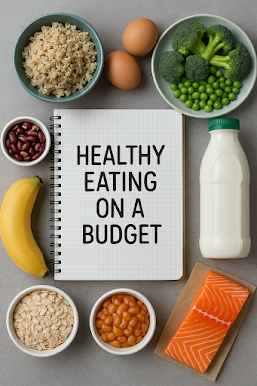Introduction
Eating healthy is often associated with high grocery bills and expensive organic stores. However, nutritious meals don't have to drain your wallet. With strategic planning, smart shopping, and a bit of creativity, anyone can enjoy healthy food without overspending. This guide dives into practical tips, meal ideas, and strategies to help you maintain a nutritious diet on a budget.
Chapter 1: Understanding the Basics of Healthy Eating
1.1 What Constitutes a Healthy Diet?
A healthy diet consists of a balance of macronutrients (carbohydrates, proteins, and fats), micronutrients (vitamins and minerals), and adequate hydration. It emphasizes whole foods like vegetables, fruits, whole grains, lean proteins, and healthy fats.
1.2 Common Myths about Healthy Eating
-
Myth: Healthy food is always expensive.
-
Fact: Many affordable staples like beans, lentils, rice, and seasonal produce are incredibly nutritious.
-
Myth: You need superfoods and supplements to be healthy.
-
Fact: Regular whole foods can provide all the nutrients your body needs.
Chapter 2: Smart Budgeting and Meal Planning
2.1 Setting a Grocery Budget
Determine your monthly or weekly budget for groceries. Track your spending to identify patterns and areas for improvement.
2.2 Planning Meals Ahead
-
Create a weekly meal plan based on sales and what’s already in your pantry.
-
Incorporate leftovers into your plan to reduce waste.
-
Cook in batches to save time and money.
2.3 Shopping List Essentials
Stick to your list to avoid impulse purchases. Include budget-friendly, nutrient-rich staples like:
-
Brown rice
-
Whole grain pasta
-
Oats
-
Canned beans
-
Frozen vegetables
-
Eggs
-
Canned tuna
-
Peanut butter
-
Seasonal fruits
Chapter 3: Grocery Shopping Hacks
3.1 Where to Shop
-
Discount Grocery Stores: Stores like Aldi or Lidl offer significant savings.
-
Farmers Markets: Great for affordable, local, and fresh produce.
-
Warehouse Clubs: Buying in bulk can lower the price per unit.
3.2 How to Shop
-
Shop with a full stomach to avoid impulse buys.
-
Buy generic/store brands.
-
Use coupons and cashback apps.
-
Compare unit prices, not just the total cost.
-
Avoid pre-cut, pre-packaged foods.
3.3 Buying Seasonal and Frozen Produce
Seasonal produce is fresher, tastier, and cheaper. Frozen fruits and veggies are also nutritious and have a longer shelf life.
Chapter 4: Cooking at Home
4.1 Benefits of Cooking at Home
-
Cost-effective
-
Full control over ingredients
-
Portion control
-
Customizable meals
4.2 Cooking in Bulk
Prepare large portions and freeze individual servings. Great for soups, stews, casseroles, and grains.
4.3 Minimizing Food Waste
-
Store food properly.
-
Use leftovers creatively (e.g., stir-fry, wraps, salads).
-
Learn proper portion sizes.
Chapter 5: Budget-Friendly Superfoods
Some superfoods are budget-friendly and nutrient-dense:
-
Oats: High in fiber and versatile for meals.
-
Eggs: Complete protein and affordable.
-
Canned sardines/tuna: Rich in omega-3s.
-
Sweet potatoes: Packed with vitamins and fiber.
-
Bananas: Great source of potassium.
-
Spinach: Available frozen and fresh.
Chapter 6: Sample Meal Plans
6.1 Weekly Meal Plan Example
Breakfasts:
-
Overnight oats with banana and peanut butter
-
Scrambled eggs with toast and spinach
-
Greek yogurt with frozen berries
Lunches:
-
Lentil soup with whole grain bread
-
Tuna salad wrap
-
Brown rice with black beans and sautéed veggies
Dinners:
-
Baked sweet potato with cottage cheese
-
Stir-fried tofu with broccoli and rice
-
Spaghetti with marinara and sautéed vegetables
Snacks:
-
Hummus with carrot sticks
-
Popcorn
-
Apple with peanut butter
6.2 Vegetarian Meal Plan
Focuses on plant-based proteins like legumes, lentils, tofu, and whole grains.
Chapter 7: Nutritional Tips for Saving Money
7.1 Understand Portion Sizes
Eating appropriate portions prevents overeating and food waste.
7.2 Prioritize Whole Foods
Minimize processed foods and maximize nutritional value.
7.3 Incorporate More Plant-Based Meals
Plant-based proteins are often cheaper and healthier.
7.4 Use Herbs and Spices
Elevate simple meals without the cost of fancy ingredients.
Chapter 8: Healthy Eating for Families
8.1 Meal Planning for Families
Involve the whole family in meal planning and preparation. Kids can help with age-appropriate tasks.
8.2 Affordable Family Favorites
-
Mac and cheese with added veggies
-
Baked chicken with roasted potatoes and carrots
-
Rice and beans with salsa
8.3 School Lunch Ideas
-
DIY lunchables with whole grain crackers, cheese, fruit
-
Leftover wraps
-
Veggie pasta salads
Chapter 9: Tools and Resources
9.1 Helpful Apps
-
Mealime: For meal planning
-
Flipp: To find local grocery deals
-
Yummly: Recipe inspiration based on ingredients you have
9.2 Community Resources
-
Food banks and pantries
-
Community gardens
-
SNAP and WIC programs
Chapter 10: Lifestyle Changes for Long-Term Success
10.1 Develop Healthy Habits
-
Cook more meals at home
-
Pack your lunch
-
Drink more water
10.2 Learn to Read Nutrition Labels
Identify hidden sugars, sodium, and unhealthy fats.
10.3 Stay Consistent
It’s okay to indulge occasionally, but consistency matters more for long-term health.
Conclusion
Eating healthy on a budget is entirely achievable with the right mindset and tools. It’s not about deprivation but about making informed, intentional choices. Prioritize whole foods, cook at home, and shop smart. With practice, you’ll find that nutritious eating can be affordable, satisfying, and enjoyable.
Stay tuned for recipes, shopping lists, and downloadable meal planning templates to support your journey!



Post a Comment